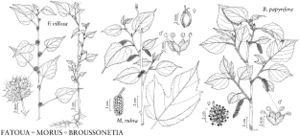Difference between revisions of "Broussonetia papyrifera"
Tabl. Règn. Vég. 3: 547. 1799.
FNA>Volume Importer |
FNA>Volume Importer |
||
| Line 40: | Line 40: | ||
|elevation=0-600 m | |elevation=0-600 m | ||
|distribution=Ala.;Ark.;Conn.;Del.;D.C.;Fla.;Ga.;Ill.;Iowa;Kans.;Ky.;La.;Md.;Mass.;Miss.;Mo.;Nebr.;N.J.;N.Y.;N.C.;Okla.;Pa.;R.I.;S.C.;Tenn.;Tex.;Va.;W.Va.;native to Asia. | |distribution=Ala.;Ark.;Conn.;Del.;D.C.;Fla.;Ga.;Ill.;Iowa;Kans.;Ky.;La.;Md.;Mass.;Miss.;Mo.;Nebr.;N.J.;N.Y.;N.C.;Okla.;Pa.;R.I.;S.C.;Tenn.;Tex.;Va.;W.Va.;native to Asia. | ||
| − | |discussion=<p>Broussonetia papyrifera is now widely naturalized in eastern United States. Frequently planted as a shade tree around dwellings, it is often considered undesirable because of its aggressiveness, shallow root system, and soft, brittle wood. The bark of the tree is used to produce a barkcloth.</p> | + | |discussion=<p><i>Broussonetia papyrifera</i> is now widely naturalized in eastern United States. Frequently planted as a shade tree around dwellings, it is often considered undesirable because of its aggressiveness, shallow root system, and soft, brittle wood. The bark of the tree is used to produce a barkcloth.</p> |
|tables= | |tables= | ||
|references= | |references= | ||
| Line 65: | Line 65: | ||
|publication year=1799 | |publication year=1799 | ||
|special status=Selected by author to be illustrated;Weedy;Introduced | |special status=Selected by author to be illustrated;Weedy;Introduced | ||
| − | |source xml=https://jpend@bitbucket.org/aafc-mbb/fna-data-curation.git/src/ | + | |source xml=https://jpend@bitbucket.org/aafc-mbb/fna-data-curation.git/src/8f726806613d60c220dc4493de13607dd3150896/coarse_grained_fna_xml/V3/V3_32.xml |
|genus=Broussonetia | |genus=Broussonetia | ||
|species=Broussonetia papyrifera | |species=Broussonetia papyrifera | ||
Revision as of 17:16, 18 September 2019
Trees, to 15 m. Bark tan, smooth or moderately furrowed. Branchlets brown, spreading pubescent. Terminal bud absent, axillary buds dark brown, short-pubescent; leaf scars nearly circular, somewhat elevated. Leaves: stipules ovate to ovate-oblong, apex attenuate; petiole shorter than or equal to blade. Leaf blade entire or 3-5-lobed, 6-20 × 5-15 cm, base shallowly cordate, often oblique, truncate, or broadly rounded, margins serrate, apex acuminate; surfaces abaxially densely gray-pubescent, adaxially scabrous. Staminate inflorescences 6-8 cm; peduncle 2-4 cm. Pistillate inflorescences ca. 2 cm diam., villous. Staminate flowers: sepals pubescent. Pistillate flowers: style elongate-filiform. Syncarps globose, 2-3 cm diam.; drupes red or orange, oblanceolate, each exserted from its calyx.
Phenology: Flowering spring.
Habitat: Disturbed thickets
Elevation: 0-600 m
Distribution

Ala., Ark., Conn., Del., D.C., Fla., Ga., Ill., Iowa, Kans., Ky., La., Md., Mass., Miss., Mo., Nebr., N.J., N.Y., N.C., Okla., Pa., R.I., S.C., Tenn., Tex., Va., W.Va., native to Asia.
Discussion
Broussonetia papyrifera is now widely naturalized in eastern United States. Frequently planted as a shade tree around dwellings, it is often considered undesirable because of its aggressiveness, shallow root system, and soft, brittle wood. The bark of the tree is used to produce a barkcloth.
Selected References
None.
